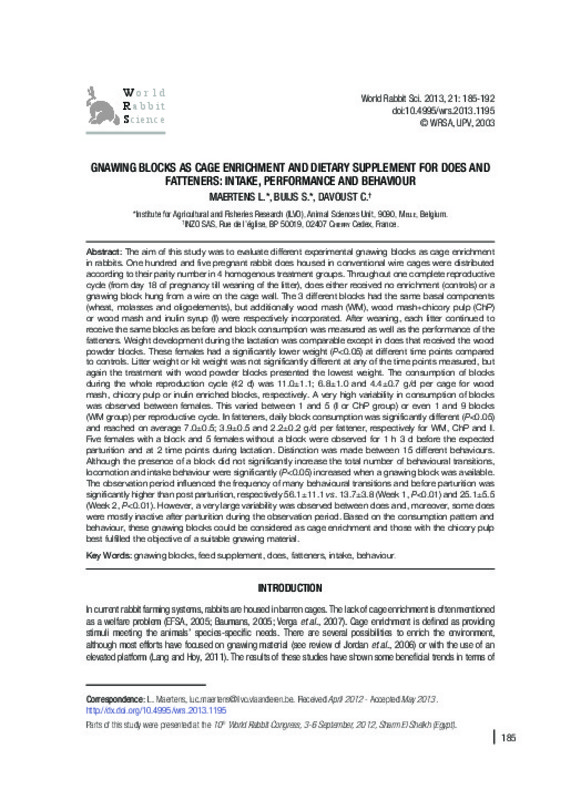|
Resumen:
|
[EN] The aim of this study was to evaluate different experimental gnawing blocks as cage enrichment in rabbits. One hundred and five pregnant rabbit does housed in conventional wire cages were distributed according to their ...[+]
[EN] The aim of this study was to evaluate different experimental gnawing blocks as cage enrichment in rabbits. One hundred and five pregnant rabbit does housed in conventional wire cages were distributed according to their parity number in 4 homogenous treatment groups. Throughout one complete reproductive cycle (from day 18 of pregnancy till weaning of the litter), does either received no enrichment (controls) or a gnawing block hung from a wire on the cage wall. The 3 different blocks had the same basal components (wheat, molasses and oligoelements), but additionally wood mash (WM), wood mash+chicory pulp (ChP) or wood mash and inulin syrup (I) were respectively incorporated. After weaning, each litter continued to receive the same blocks as before and block consumption was measured as well as the performance of the fatteners. Weight development during the lactation was comparable except in does that received the wood powder blocks. These females had a significantly lower weight (P<0.05) at different time points compared to controls. Litter weight or kit weight was not significantly different at any of the time points measured, but again the treatment with wood powder blocks presented the lowest weight. The consumption of blocks during the whole reproduction cycle (42 d) was 11.0±1.1; 6.8±1.0 and 4.4±0.7 g/d per cage for wood mash, chicory pulp or inulin enriched blocks, respectively. A very high variability in consumption of blocks was observed between females. This varied between 1 and 5 (I or ChP group) or even 1 and 9 blocks (WM group) per reproductive cycle. In fatteners, daily block consumption was significantly different (P<0.05) and reached on average 7.0±0.5; 3.9±0.5 and 2.2±0.2 g/d per fattener, respectively for WM, ChP and I. Five females with a block and 5 females without a block were observed for 1 h 3 d before the expected parturition and at 2 time points during lactation. Distinction was made between 15 different behaviours. Although the presence of a block did not significantly increase the total number of behavioural transitions, locomotion and intake behaviour were significantly (P<0.05) increased when a gnawing block was available. The observation period influenced the frequency of many behavioural transitions and before parturition was significantly higher than post parturition, respectively 56.1±11.1 vs. 13.7±3.8 (Week 1, P<0.01) and 25.1±5.5 (Week 2, P<0.01). However, a very large variability was observed between does and, moreover, some does were mostly inactive after parturition during the observation period. Based on the consumption pattern and behaviour, these gnawing blocks could be considered as cage enrichment and those with the chicory pulp best fulfilled the objective of a suitable gnawing material.
[-]
|
|
Agradecimientos:
|
The authors are very grateful to Andre Vermeulen and Raoul Lemmens for their assistance during the trial and for carrying the animals. This trial was financially supported by the following companies: Nutrilac, Trouw Nutrition ...[+]
The authors are very grateful to Andre Vermeulen and Raoul Lemmens for their assistance during the trial and for carrying the animals. This trial was financially supported by the following companies: Nutrilac, Trouw Nutrition and Orafti.
[-]
|








